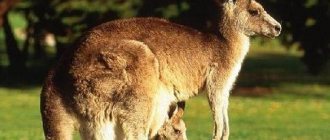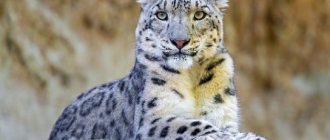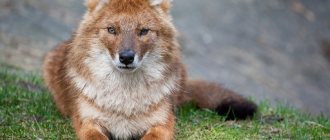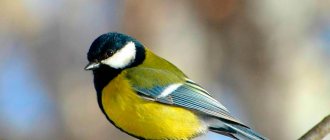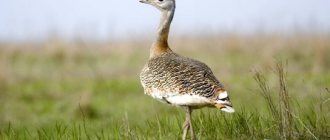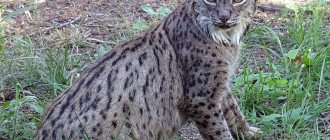- Encyclopedia
- Animals
- Lynx
Lynx is a mammal. The size of the lynx is about 90-130 centimeters in length and about 80 centimeters at the withers. Females weigh slightly less than males. The weight of males is 20-25 kilograms, and that of females is about 18 kilograms.
Externally, lynxes are quite dense animals. They have a small head with wide eyes with “whiskers” on the sides made of wool. The fur on the body is rich, it is very thick and silky.
The color of the fur varies and depends on the habitat of the animal. Color gradient from reddish-brown to smoky. There are individuals with spots on the sides and back.
Lynxes mainly live in the northern regions. It is found in dense coniferous forests and taiga. Popularization is very low, so now there is an active revival. The lynx's favorite pastime is climbing trees and rocks. Swims great. In places where there are no problems with food, the lynx leads a sedentary lifestyle. And if there are problems with food, then nomadic. They eat hares, rodents, roe deer, and sometimes reindeer. Lynx is a predatory animal. Sometimes attacks dogs, partridges and small ungulates. Hunting most often occurs in the dark. The lynx sneaks up from behind and attacks the prey. It does not eat the prey all at once. Hides some of the food.
The lynx is well camouflaged in tree branches. Her favorite place is fallen tree trunks.
In nature, the lynx plays the same role as wolves. They mainly catch weak and sick individuals. Humans are attacked on rare occasions. Scientists report that no such cases have been recorded.
The mating season for lynxes begins in the spring. During this period, lynxes make a rumbling sound. Usually a female is pursued by several males. They fight among themselves and the strongest wins. The marriage ritual is as follows. The male approaches the female, they sniff each other, touch their noses and begin to lick the fur. This gesture is a friendly affection.
Females carry their cubs for about 70 days. Usually 3 babies are born. The female lives in the den with her cubs. Usually this is a cave or pit. As soon as the little lynx cubs grow up, they begin to hunt with the adults. Then they begin to live separately. The average life is about 20 years.
As already mentioned, the lynx has rich fur. He is very much appreciated by people. The length of the fur reaches 5 centimeters.
Meat is not in demand at present. It is not customary to use it. Although previously it was considered a delicacy. In Ancient Rus', this delicacy was placed on the table for guests. It tastes like tender veal.
Report about Lynx
The lynx is a predatory mammal from the big cat family. There are four species of these animals: the common lynx, the Iberian lynx, the red lynx and the Canadian lynx.
Outwardly, these animals look like real domestic cats, but are the size of a large dog. A distinctive feature of these big cats is the presence of tufts at the ends of their ears and a relatively short tail.
The common lynx is a northern animal that loves coniferous, deciduous, or mixed forests. Common lynxes live in Europe; they can be found in Russia, Siberia and the Caucasus, Poland, Finland, Sweden and Norway. Representatives of this subspecies are the largest among lynxes. The food of these animals are hares, roe deer, voles, deer, young wild boars, and sometimes livestock and poultry. Lynxes love to hunt either at night or early in the morning.
The Iberian lynx, or also called the Spanish lynx, has a relatively small head, long legs and a small tail, which is necessarily covered at the end with a black tassel, and also has hair on its cheeks that is similar to sideburns, like in humans. The Spanish lynx lives in Europe on the Iberian Peninsula, Spain and Portugal. The prey of this animal is usually rabbits, partridges and young deer.
The red lynx lives in North America - in the USA and Canada. A distinctive feature of this subspecies is the coat color - it is brown or brown-red, and the tips of the tails are black and white, and not black, like other representatives. These animals are also called red lynxes. These animals hunt birds, rabbits and small rodents.
The Canadian lynx, or also called the North American lynx, lives in the forests of Canada, Alaska and the USA. A distinctive feature of this type of lynx is that they hunt not only at night, but also during the day. This animal detects its prey by smell and tracks, and then looks out high in the trees. The Canadian lynx's favorite food is the mountain hare, as well as beavers, birds, mice, squirrels, fish, young deer and sheep.
Thanks to humans, the populations of these beautiful animals are only decreasing every year, and they are in danger of extinction. All lynx species are listed in the Red Book.
2nd, 3rd, 4th grade. The world
Population and species status
On the territory of the Balkan Peninsula there are no more than a few dozen individuals, and in Germany, Switzerland and France at one time lynxes were completely exterminated, which required their repopulation.
The largest numbers of this predator are observed in the Carpathians and Poland. No less numerous populations are also characteristic of Belarus, Scandinavia, Central Asia, Latvia and Estonia. This representative of the cat family is also found in Siberia.
The common lynx is not of particular importance for commercial production, although the fur of this animal is highly valued. This is due to the fact that the lynx has thick, silky and long (up to 7 cm) fur, with a rather thick and warm undercoat. It should be noted that lynxes play a very important role in maintaining the balance of nature.
It is believed that the taste characteristics of lynx meat are quite high, since its taste characteristics are similar to veal. Despite this, in most countries lynx meat is not eaten, although it is quite tasty and tender.
Interesting to know! In ancient times in Rus', rich nobles were treated to lynx meat, and dishes prepared from the meat of this animal were always present on the tables of boyars and princes as an expensive delicacy.
A characteristic feature of European territory is the fact that even in the last century the number of lynxes did not exceed several hundred individuals.
In the territory of European countries, even in the last century, the number of common lynx decreased significantly and amounted to only a few hundred individuals. This became possible due to the fact that forests began to be actively destroyed, poaching began to flourish, and against this background the food supply was reduced. Nowadays, a lot of measures are being taken that are aimed at preserving the populations of this unique animal, as well as, if possible, increasing its numbers.
Special differences
Wikipedia indicates the following features as characteristic features of the appearance of lynxes :
- A rather short tail, which reaches a length of 5 to 30 cm in different species of animals.
- Tassels at the tips of the ears, consisting of black wool, which can reach 5 cm in length. This anatomical feature helps to better capture sounds, which affects the already acute hearing of a wild cat.
A textual presentation of information about the lynx looks incomplete without pictures and photographs depicting this animal. The illustrations clearly show the differences between different species, the peculiarities of coat color, which varies among different animal species from field-smoky to rusty-red.
In addition to shade, the degree of spotting is also highly variable.
The difference between the subfamily of small cats, to which the lynx belongs, and the family of large cats lies in the structural features of the hyoid bone. This anatomical feature does not allow lynxes to growl loudly. However, these animals are capable of hissing, meowing and purring.
Nutrition
Excellent physical fitness, the ability to climb tree branches and rocks, as well as swim and jump, excellent sense of smell, vision and hearing make the lynx a first-class hunter. During the daytime, the lynx rests to get food.
She starts from about three o'clock in the morning until dawn. Only the Canadian lynx goes hunting during the day. In an ambush, an animal, without moving, can wait for a victim for a very long time; spots on its fur perfectly camouflage it among the environment.
This cat never hunts from trees, being on branches, it only looks out for prey. Having tracked down the prey, the predator attacks, while jumping several meters.
If it is not possible to immediately catch the prey, it chases it for 100 meters and, if unsuccessful, stops the attempt. The speed of the animal is approximately 20 km per hour, the maximum is up to 40 km per hour. In search of prey, a predatory cat can walk up to 30 km per day.
A predator requires several kilograms of meat per day, however, a hungry animal can eat up to 6 kg per day. A well-fed lynx is resting. The rest of the prey is buried in the snow or ground. By the way, he hides his prey inaccurately. Other animals calmly find the cache and eat the supply.
Very often, having hidden food, the lynx never returns to it. The main diet of the lynx is the mountain hare, but the diet also includes various rodents, squirrels, raccoons and birds. From time to time, larger game is encountered: roe deer, deer, chamois, elk, wild boar.
If an animal lives close to people, its prey may be livestock. In the spring, when fish spawn in shallow water, the lynx stuffs its paw in any quantity and feasts on it with pleasure.
Reproduction and lifespan
From the beginning of spring to summer, the lynx's mating season begins. Several males, who constantly accompany the female, constantly fight, meow, growl and scream. These sounds can be heard over a long distance. When the female gives preference to the most dexterous and strong, the animals create a family.
A couple in love licks each other, sniffs each other and begins to lightly and tenderly butt heads with each other. Next comes the arrangement of the home, which can be located in the roots of a tree, a hollow, an earthen cave or a rock crevice. They line their house with grass, animal hair and feathers.
After 2-2.5 months, 2-4 babies are born, weighing approximately 300 g, hearing nothing and deaf. However, after a week, the parents begin to raise the little hunter from the kitten. They bring a small rodent or bird and hide it.
The child’s task is to find them. At three months, lynx cubs are already hunting with their mother, and at five months of age they learn to independently obtain food for themselves. When the kittens turn one year old, the mother lynx drives them away and has new offspring.
The female is ready to mate at about one and a half years, males at two and a half. The lifespan of predators in nature reaches 20 years, in captivity this figure reaches 25.
Nowadays keeping wild flora in houses and apartments is becoming fashionable. When purchasing an animal such as a lynx, you must take into account that they need a large living space and special care.
The habits of this wild animal do not make it possible to keep it in an apartment, however, today the “Domestic Lynx” breed has been bred by crossing a wild lynx and a cat with the appropriate coat color. The price for a lynx is quite high, but it is worth it if you have such a smart, beautiful and graceful pet.
Interesting answers
Solar energy on Earth is used in different forms. Quite difficult processes take place on the Sun itself, which make it possible to release the energy necessary for life on the entire planet.
Alexander Melentyevich Volkov (1891-1977) belongs to the famous galaxy of Soviet writers, working in the genre of historical novels and fairy tales.
The human heart is one of the most important organs. An organ without which human life is impossible. It is known that the heart pumps blood. Human blood supplies the body with nutrients and oxygen
Glass is universal in application and is currently widely used in almost all areas of life in the world. When heated to maximum, the glass can be shaped into the desired shape.
Source
Character and lifestyle of the lynx
Lynx is a wild animal. This big cat lives in the taiga and mountain forests. Less commonly, lynx is found in the tundra or forest-steppe. However, the predatory cat climbs trees well and feels much more confident in their branches than on the ground.
The lynx is an animal of the taiga and forest , it is there that it can satisfy its hunting instinct to its fullest. The Eurasian lynx can withstand temperatures down to -55 degrees.
Each lynx lives in a specific area measuring up to 250 square meters. km, which she can walk around within 1-2 weeks. It leaves its individual territory only when there is a lack of food. The main enemies of the lynx are wolves and wolverines.
It is not known why wolves treat predatory cats this way, or whether they really like lynx meat or in the fight for food. However, the lynx fails to escape from a pack of wolves. If experienced animals hide in trees, then the young individual will almost certainly be killed by the pack.
It’s a shame, but the greatest danger to animals is humans. Poachers annually reduce the number of these noble animals. By the way, meeting a lynx is considered lucky, because it prefers to hide from people in the thickets of trees.
The lynx's excellent hearing allows it to catch steps long before its approach and escape in time. But if a person wounds a predatory cat, he can expect a powerful attack using sharp teeth and claws. An animal can easily break a person's neck, but this happens very rarely.
The lynx cannot stand the thief of a fox. The cat waits for her and kills her, leaving the corpse untouched on the spot. Curiously, the wild cat has an interesting habit of wagging its tail. It has not yet been clarified in what cases she does this.
Natural habitat
In the wild, lynxes are found only on two continents - Eurasia and North America. These animals are the northernmost species of cats, and are found even beyond the Arctic Circle.
The lynx family was once found throughout Europe but was extirpated from the western and central parts of the continent, and efforts are now being made to reintroduce the spotted beasts to countries such as Germany, France and Switzerland.
In the wild, lynxes inhabit the following regions:
- Russia, including the Far Eastern Kamchatka Peninsula and Sakhalin Island;
- Ukraine, including the Chernobyl zone;
- Poland;
- Belarus;
- Carpathian mountain range from the Czech Republic to Romania;
- Scandinavian Peninsula;
- Baltic countries;
- Balkan Peninsula;
- Transcaucasia: Armenia, Georgia, Azerbaijan;
- Central Asia: Tajikistan, Kyrgyzstan, Turkmenistan, Uzbekistan, Kazakhstan;
- China;
- Mongolia;
- Alaska;
- Canada;
- USA;
- Mexico.
Spotted cats prefer to settle in dense taiga and coniferous forests; they also like high mountain areas. Lynxes also wander into the forest-tundra, because thanks to their thick fur, they feel great among the polar snows. They can also live in steppe regions, choosing rough places with bushes.
Description
Their body is covered with beautiful thick fur, which provides warmth in cold winters. The large paws have a unique shape that makes them function like natural snowshoes.
Lynxes are long-legged cats (similar to a leopard/irbis ) with large paws, tufts on the earlobes, shaggy soles and a short tail. Coat, yellowish-brown to cream in color with small spots of brown and black; the tip of the tail and earlobes are black. In winter, the fur is thick and soft, with hairs up to 10 cm in length.
They also have features shared with other carnivores: large fangs and well-developed carnassial teeth.
Most lynxes measure approximately 80 to 120 cm in length, without a tail from 10 to 20 cm and have a height of about 60 cm. Weight usually ranges from 10 to 20 kg. In all species, males are larger than females.

